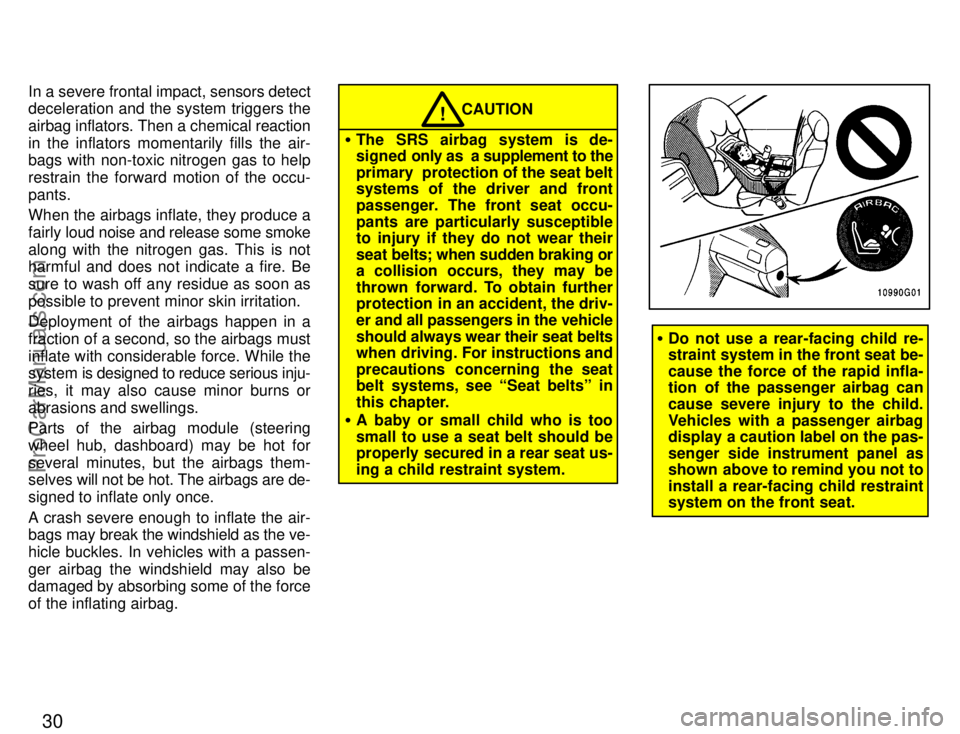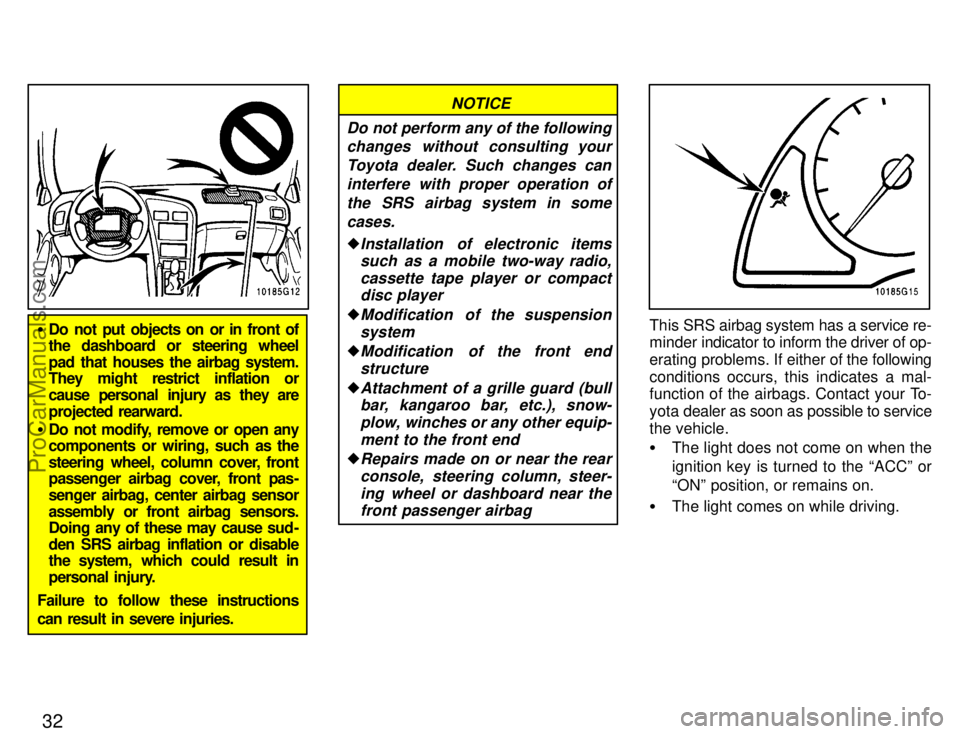Page 34 of 203

28
The SRS (Supplemental Restraint Sys-
tem) airbags are designed to provide
further protection to the driver and
front passenger when added to the pri-
mary protection provided by the seat
belts.
In response to a severe frontal impact, the
SRS airbags work together with the seat
belts to help prevent or reduce injury by in-
flating, in order to decrease the likelihood
of the driver's or front passenger's head
or chest directly hitting the steering wheel
or dashboard. The passenger airbag is
activated together with the driver airbag,
even with no passenger in the front seat.This indicator comes on when the
ignition key is turned to the ACCº or
ONº position. It goes off after about 6
seconds. This means the SRS airbags
are operating properly.
The SRS airbag warning light system
monitors the front airbag sensors, center
airbag sensor assembly, inflators, warn-
ing light, interconnecting wiring and power
sources.The SRS airbag system is designed to
activate in response to a severe frontal
impact within the shaded area be-
tween the arrows in the illustration.
The SRS airbags will deploy if the severity
of the impact is above the designed
threshold level, comparable to an approxi-
mate 20 km/h (14 mph) collision when im-
pacting straight into a fixed barrier that
does not move or deform.
If the severity of the impact is below the
above threshold level, the SRS airbags
may not deploy.
SRS airbags
ProCarManuals.com
Page 36 of 203

30
In a severe frontal impact, sensors detect
deceleration and the system triggers the
airbag inflators. Then a chemical reaction
in the inflators momentarily fills the air-
bags with non-toxic nitrogen gas to help
restrain the forward motion of the occu-
pants.
When the airbags inflate, they produce a
fairly loud noise and release some smoke
along with the nitrogen gas. This is not
harmful and does not indicate a fire. Be
sure to wash off any residue as soon as
possible to prevent minor skin irritation.
Deployment of the airbags happen in a
fraction of a second, so the airbags must
inflate with considerable force. While the
system is designed to reduce serious inju-
ries, it may also cause minor burns or
abrasions and swellings.
Parts of the airbag module (steering
wheel hub, dashboard) may be hot for
several minutes, but the airbags them-
selves w ill not be hot. The airbags are de-
signed to inflate only once.
A crash severe enough to inflate the air-
bags may break the windshield as the ve-
hicle buckles. In vehicles with a passen-
ger airbag the windshield may also be
damaged by absorbing some of the force
of the inflating airbag.
CAUTION!
� The SRS airbag system is de-
signed only as a supplement to the
primary protection of the seat belt
systems of the driver and front
passenger. The front seat occu-
pants are particularly susceptible
to injury if they do not wear their
seat belts; when sudden braking or
a collision occurs, they may be
thrown forward. To obtain further
protection in an accident, the driv-
er and all passengers in the vehicle
should always wear their seat belts
when driving. For instructions and
precautions concerning the seat
belt systems, see Seat beltsº in
this chapter.
� A baby or small child who is too
small to use a seat belt should be
properly secured in a rear seat us-
ing a child restraint system.
�Do not use a rear-facing child re-
straint system in the front seat be-
cause the force of the rapid infla-
tion of the passenger airbag can
cause severe injury to the child.
Vehicles with a passenger airbag
display a caution label on the pas-
senger side instrument panel as
shown above to remind you not to
install a rear-facing child restraint
system on the front seat.
ProCarManuals.com
Page 37 of 203
31
�When using a forward-facing child
restraint system in the front seat,
the seat must be moved as far back
as possible. For instructions con-
cerning the installation of a child
restraint system, see Child re-
straintº in this chapter.� Do not sit on the edge of the seat
or lean over the dashboard when
the vehicle is in use. The airbags
inflate with considerable speed
and force; you may be severely in-
jured. Sit up straight and well back
in the seat, and always use the
seat belts.� Do not allow a child to stand up, or
to kneel on the front passenger
seat. The airbag inflates with con-
siderable speed and force; the
child may be severely injured.
� Do not hold a child on your lap or
in your arms. Use a child restraint
system in the rear seat. For instruc-
tions concerning the installation of
a child restraint system, see Child
restraintº in this chapter.
ProCarManuals.com
Page 38 of 203

32
�Do not put objects on or in front of
the dashboard or steering wheel
pad that houses the airbag system.
They might restrict inflation or
cause personal injury as they are
projected rearward.
� Do not modify, remove or open any
components or wiring, such as the
steering wheel, column cover, front
passenger airbag cover, front pas-
senger airbag, center airbag sensor
assembly or front airbag sensors.
Doing any of these may cause sud -
den SRS airbag inflation or disable
the system, which could result in
personal injury.
Failure to follow these instructions
can result in severe injuries.
Do not perform any of the following changes without consulting your
Toyota dealer. Such changes caninterfere with proper operation ofthe SRS airbag system in somecases.
�Installation of electronic itemssuch as a mobile two-way radio,
cassette tape player or compactdisc player
�Modification of the suspension
system
�Modification of the front endstructure
�Attachment of a grille guard (bullbar, kangaroo bar, etc.), snow-
plow, winches or any other equip-ment to the front end
�Repairs made on or near the rearconsole, steering column, steer-ing wheel or dashboard near thefront passenger airbag
NOTICE
This SRS airbag system has a service re-
minder indicator to inf orm the driver of op-
erating problems. If either of the following
conditions occurs, this indicates a mal-
function of the airbags. Contact your To-
yota dealer as soon as possible to service
the vehicle.
� The light does not come on when the
ignition key is turned to the ACCº or
ONº position, or remains on.
� The light comes on while driving.
ProCarManuals.com